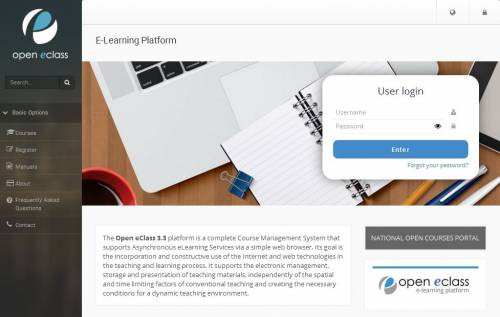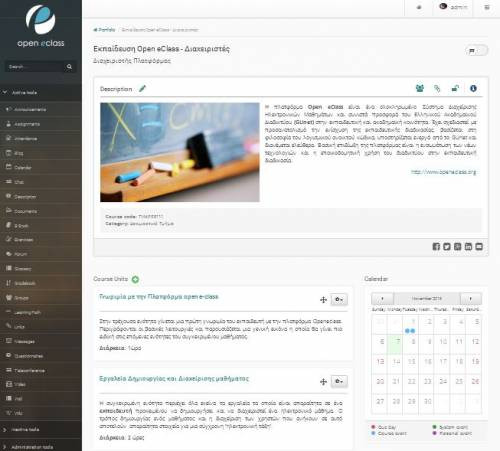This is an old revision of the document!
Short Description
The Open eClass platform is an integrated e-Course Management System and is the proposal of the Academic Internet (GUnet) for the support of Asynchronous Distance Learning Services. It has been designed with an orientation to enhance the educational process, is based on the philosophy of open source software, is actively supported by GUnet and is freely distributed. The introduction of Asynchronous Telemedicine opens up new possibilities in education, offering a means of interaction and continuous communication between the trainer and the trainee. At the same time, the electronic organization, storage and presentation of educational material is supported, independent of the limiting factors of space and time of traditional teaching, creating the conditions for a dynamic educational environment. The Open eClass platform is designed to implement new educational activities.
Features and functionalities
Compatibility with all browsers: Open eClass is accessed using a simple web browser. The Open eClass platform is fully functional in all browsers.
Customizable user interface: The Open eClass platform features a modern and responsive user interface, based on Bootstrap 3x, to adapt to the screens of different devices, including computers, tablets and smartphones. Users can also access Open eClass directly on their tablet or mobile device and through mobile apps for iOS and Android mobile devices.
Compatibility with e-learning standards: the Open eClass platform is compatible with international standards (SCORM, IMSCP) which ensure the reusability, accessibility and resilience of the educational material to technological changes, as well as interoperability between e-learning systems.
Creation & Management of Online Courses. Specifically, the platform supports:
- distinct ways of accessing courses: open courses, courses requiring registration, closed courses, inactive courses
- discrete course formats: simple format, weekly format, module-based course
- backups: ensuring the entire course content in case of accidental deletion or destruction of the course.
- distinct user roles: teacher, student, administrator (additional roles: teacher assistant, Group Turor, guest),Reviewer.
Management of educational content
- Documents: Organising, storing and presenting course content.
- Multimedia: storage and distribution of audiovisual material.
- Blog: Publishing text posts in chronological order.
- Glossary: Adding and managing key terms .
- E-book: Posting, managing and presenting e-books in HTML format.
- Wall: Reading of multi-content posts (video, documents, multimedia).
- Links: Adding and organizing useful resources from the Internet .
- Learning Path: Organization of educational material into structured modules. Export to SCORM package.
- H5P content: a tool for creating interactive course objects
- Mindmap: Conceptual analysis of course concepts.
Information, communication & cooperation tools
- Announcements: Posting of course announcements.
- Calendar: Chronological presentation of events-stages of the course.
- Messages: Exchange of messages between instructors and trainees.
- Announcments: Notification of anything new regarding the course.
- Forum: Asynchronous exchange of views and ideas.
- Teleconference: the ability to communicate and collaborate in real time.
- Groups: Grouping users to have a common discussion area and file upload area.
- Wiki: Collaborative authoring.
- Chat: Real-time communication by text message, between instructors and learners.
Evaluation & feedback tools
Exercises: Production of closed-ended exercises (multiple choice, matching, fill-in-the-blank).
Assignments: Management, submission and marking of assignments. Questionnaires: Creating polls and surveys. Grading: Recording trainee scores. Presentation log: Recording trainee attendance/absence. Progress: helps learners to improve their performance and achieve their goals Statistics: User statistics.
E-learning management tools
Settings: the basic course settings tool (title, description, metadata, format, access, licenses, etc.). User Management: List of registered users, roles, registration and de-registration of users (individual, group or with rules). Tool Management: enable, disable, add external tools (links, tools, LTI, etc.). Learning analytics: Analytical reports on monitoring and achievement of learning objectives.
The eCourse is the core part of the Open eClass platform. Each eCourse is an autonomous entity which integrates a number of learning tools. More specifically, each eCourse consists of the following learning tools - components which can be enabled and maintained by the teachers:
- Agenda, presents crucial course events in time order (lectures, meetings, etc)
- Documents, educational materials available to students (documents, presentations, images ,etc)
- Announcements, concerning the course; they can be optionally e-mailed to students
- Forums, where students can participate in conversation groups and exchange opinions on various aspects of the course
- Groups, open or closed, consist of users registered to the course (students and teachers)
- Links, on the web to resources relevant to the aspects of the course
- Student Assignments, where students can submit work done in response to assignments set forward by the teacher
- Self-evaluation Exercises, created by the teacher, allowing students to practice and test their knowledge
- Course Description, presents information about course goals, structure, teachers in charge, etc.
- Glossary, space for adding and managing the terms contained in the course.
- E-Book, a module for uploading and presenting electronic books in HTML format
- Multimedia, where recorded lectures or other multimedia files can be stored and presented to students, either as multimedia files or as external links to multimedia recourses
- Learning Path allows teachers to organize their educational material and students to follow a sequence of learning activity steps (SCORM)
- Wiki, where course participants collaborate on documents, allowing everyone to edit document pages while maintaining full history of changes
- Teleconference, combining real-time on-line conversations, and message exchange
- Questionnaires, which can be used for polls and learning profile surveys
- Drop Box, is a file and messaging exchange area for students and teachers
- Course Administration Tools, allowing teachers to configure course information (title, keywords, etc.), control eCourse access settings, renew or delete the eCourse, manage registered users, view usage statistics and activate / deactivate eCourse learning tools.
- Atendance students can check their exercises, tasks, activities, workshops.
- Wall allow students and teachers to apply in chronological order a set of multiple content posts
- Video teachers can upload multimedia files in several formats like mpeg, avi, flv, etc.
- Gradebook allow teachers to create and manage a series of “Electronic score” for the course.
Course units offer a flexible way to organize educational material that is stored in the course learning modules in an articulate structure.
Aims - Benefits
The Open eClass project has the following aims:
- to incorporate new technologies in education activities.
- to utilize existing educational material (notes, presentations, etc.)
- to take constructive advantage of the Internet.
- to be easy to use for both teachers and students.
- to offer a reliable but affordable asynchronous e-learning services.
- to be easy to install and administer, as well as easy to adapt to special or changing requirements.
- to actively developed and supported by the Greek Academic Network GUnet and available without restrictions to everyone.
Contact
For more information please visit platform’s web portal in: http://www.openeclass.org

